Recipe binder is more than just a collection of culinary creations; it’s a testament to your culinary journey, a treasure trove of family favorites, and a source of inspiration for new adventures in the kitchen. Whether you prefer a physical binder adorned with handwritten notes and cherished clippings or a digital platform brimming with curated recipes, a well-organized recipe binder is a culinary essential.
From the simple act of gathering your favorite recipes to the meticulous organization by category, cuisine, or even dietary needs, creating a recipe binder allows you to personalize your culinary experience. It’s a chance to document family traditions, experiment with new flavors, and ultimately, to enjoy the art of cooking with greater ease and confidence.
Introduction to Recipe Binders
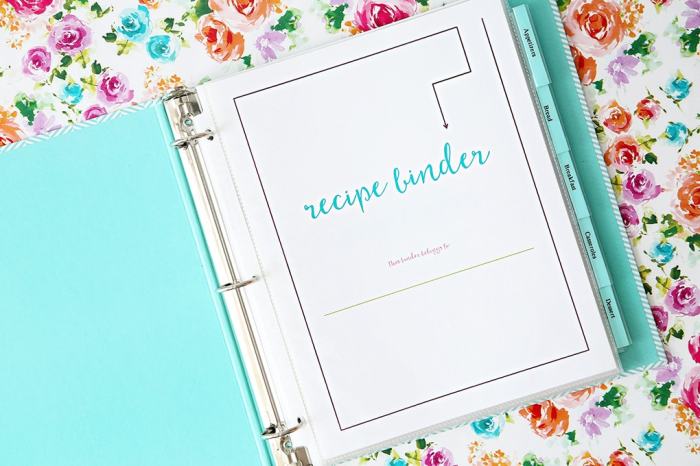
A recipe binder is a valuable tool for any home cook. It allows you to keep all your favorite recipes organized in one place, making it easy to find what you need when you’re ready to cook. Recipe binders come in various forms, each offering its own set of advantages.
Let’s explore the different types and organization methods.
Types of Recipe Binders
Recipe binders can be either physical or digital, each offering a distinct experience.
- Physical Recipe Binders:These are traditional binders with pages that hold recipes printed on paper. They offer a tangible and personalized feel, allowing you to add handwritten notes and embellishments.
- Digital Platforms:These platforms allow you to store recipes electronically, often with features like recipe organization, search functionality, and the ability to share recipes with others. Popular examples include websites like Allrecipes.com and online recipe management apps like Paprika.
- Recipe Apps:These mobile applications are designed for recipe storage and management, often offering features like ingredient shopping lists, meal planning, and recipe scaling. Examples include Yummly, Epicurious, and BigOven.
Recipe Binder Organization Methods
Organizing your recipes effectively is key to maximizing the benefits of a recipe binder.
- By Cuisine:This method groups recipes by their culinary origin, such as Italian, Mexican, or Asian. It can be helpful for exploring different cuisines and finding recipes based on your desired flavor profile.
- By Meal Type:This organization method categorizes recipes based on the meal they are intended for, such as breakfast, lunch, dinner, or dessert. It can be useful for meal planning and finding recipes for specific occasions.
- By Ingredient:This approach groups recipes based on the main ingredient they feature, such as chicken, beef, or vegetables. It can be helpful for utilizing ingredients you already have on hand or for exploring recipes centered around a particular ingredient.
- By Occasion:This method organizes recipes by the occasion they are suitable for, such as holidays, parties, or special events. It can be helpful for finding recipes for specific celebrations or gatherings.
- By Dietary Restrictions:This method categorizes recipes based on dietary needs or preferences, such as gluten-free, vegan, or vegetarian. It can be helpful for individuals with dietary restrictions or those following specific eating plans.
Creating a Recipe Binder
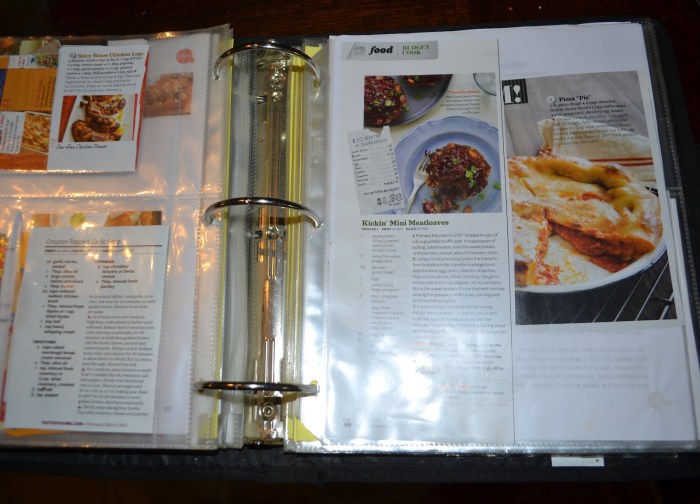
Building a recipe binder is a rewarding project that allows you to curate your favorite culinary creations in a convenient and organized manner. By taking the time to gather your recipes and assemble them into a well-structured binder, you’ll create a valuable resource for your kitchen.
Choosing the Right Binder
Selecting the right binder is crucial for creating a durable and user-friendly recipe collection. Consider the following factors:
- Size:Determine the ideal size for your needs. A standard letter-sized binder (8.5″ x 11″) is a common choice, but consider a smaller binder if you prefer portability.
- Material:Opt for a sturdy binder made of durable materials such as plastic, metal, or leather. These materials will withstand frequent use and keep your recipes protected.
- Mechanism:Choose a binder with a reliable mechanism, such as a three-ring binder, that allows you to easily add and remove pages.
Selecting Dividers and Other Materials
Dividers and other materials can enhance the functionality and visual appeal of your recipe binder. Consider the following options:
- Dividers:Use dividers to categorize your recipes by cuisine, meal type, or other criteria. Choose dividers with clear labels or write your own labels using a permanent marker.
- Page Protectors:Protect your recipes from spills and wear and tear by using page protectors. These are particularly helpful for recipes that you frequently use.
- Decorative Elements:Add personal touches to your binder with decorative elements such as ribbons, stickers, or fabric covers. These elements can make your binder more visually appealing and reflect your personal style.
Organizing Recipes
Organizing your recipes effectively ensures you can easily find the recipe you’re looking for. Consider the following organization methods:
- By Category:Divide your recipes into categories such as appetizers, main courses, desserts, or breakfast.
- By Cuisine:Organize your recipes by cuisine, such as Italian, Mexican, or Asian.
- By Meal Type:Group recipes by meal type, such as weeknight dinners, weekend brunches, or holiday meals.
- By Ingredient:Organize recipes by main ingredient, such as chicken, pasta, or vegetables. This can be particularly helpful for planning meals based on what you have on hand.
Designing a Visually Appealing Recipe Binder
A visually appealing recipe binder can make cooking more enjoyable. Consider the following design ideas:
- Color Scheme:Choose a color scheme that complements your kitchen decor or reflects your personal style.
- Font Selection:Select a font that is easy to read and visually appealing.
- Decorative Touches:Add decorative touches such as ribbons, stickers, or fabric covers to personalize your binder.
Recipe Binder Content
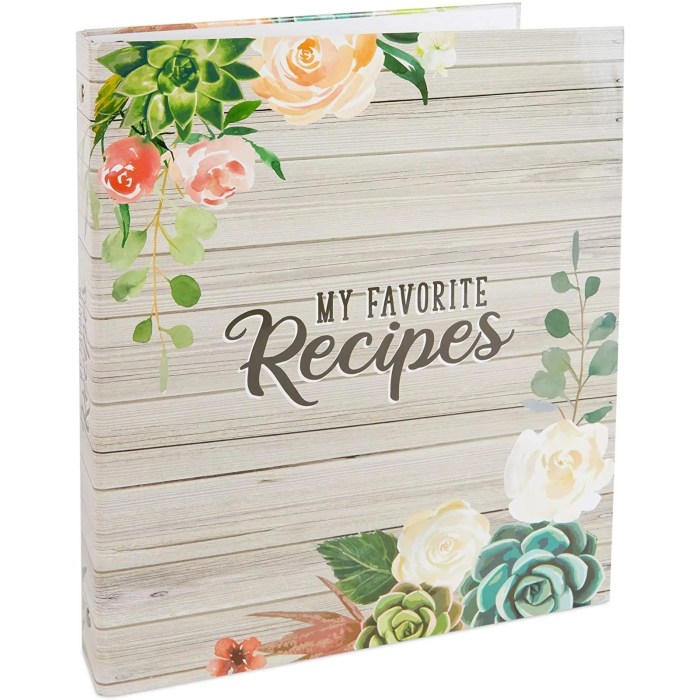
A well-organized recipe binder can be a valuable tool for any home cook, providing a centralized location for all your favorite recipes. It can include a variety of recipes, from family heirlooms to online discoveries, and cookbook staples.
Types of Recipes
A recipe binder can accommodate various types of recipes, reflecting your culinary interests and preferences.
- Family Recipes:These recipes often hold sentimental value, passed down through generations, and represent family traditions.
- Online Recipes:The internet offers a vast resource of recipes, allowing you to explore new cuisines and techniques.
- Cookbook Recipes:Cookbooks provide a curated collection of recipes, often organized by cuisine, ingredient, or occasion.
Essential Recipe Information
Each recipe card should include essential information for successful cooking:
- Ingredients:List all ingredients with precise measurements and units, ensuring clarity and consistency.
- Instructions:Provide step-by-step instructions, written in a clear and concise manner, ensuring a smooth cooking process.
- Serving Size:Indicate the number of servings the recipe yields, allowing for adjustments based on your needs.
- Cooking Time:Include the estimated preparation and cooking time, providing a realistic timeframe for meal planning.
Source Information
Including source information for each recipe is crucial for several reasons:
- Crediting the Originator:Acknowledging the source shows respect for the recipe creator’s work.
- Recipe Verification:In case of questions or inconsistencies, the source provides a reference point for clarification.
- Accessibility:The source information allows others to find and access the original recipe, expanding culinary knowledge.
Personal Touches
Adding personal touches to your recipe cards can enhance their value and create a unique culinary archive:
- Handwritten Notes:Add personal notes about your experience with the recipe, including variations, substitutions, or tips.
- Pictures:Include pictures of the finished dish, capturing its visual appeal and serving as a visual reminder.
- Clippings:Incorporate relevant clippings from magazines or newspapers, adding context or inspiration to your recipe.
Maintaining and Updating a Recipe Binder
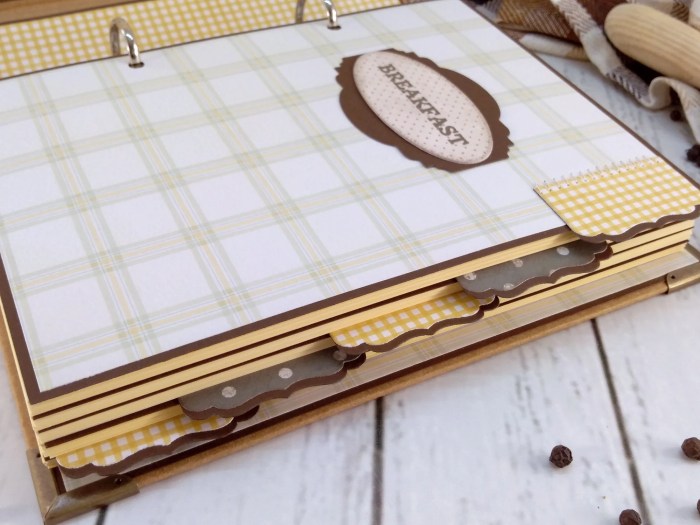
A well-maintained recipe binder is a valuable resource for any home cook. It can save you time, money, and frustration in the kitchen. Keeping your recipe binder organized and up-to-date is essential for maximizing its usefulness.
Keeping a Recipe Binder Clean and Organized
Maintaining a clean and organized recipe binder ensures easy access to your recipes.
- Use page protectors to keep recipes clean and free from spills and stains.
- Organize recipes by category, such as appetizers, main courses, desserts, or by cuisine.
- Use dividers or tabs to separate different categories of recipes.
- Consider using a three-ring binder with a clear cover for easy visibility of the contents.
Adding New Recipes and Removing Outdated Ones
Adding new recipes and removing outdated ones keeps your recipe binder relevant and useful.
- Use a system for adding new recipes, such as a designated folder or a digital file.
- When adding a new recipe, consider its source, date, and any modifications made.
- Remove outdated recipes that you no longer use or that are no longer relevant to your needs.
- Regularly review your recipe binder and remove any recipes that are no longer used or are outdated.
Creating a System for Tracking Recipe Modifications and Adjustments
Tracking modifications and adjustments to recipes ensures consistency and accuracy.
Enhance your insight with the methods and methods of tauhu recipe.
- Use a system for recording changes, such as a separate note card or a sticky note attached to the recipe.
- When making a change, record the date, the modification, and the reason for the change.
- Consider using a different color ink for modifications to easily distinguish them from the original recipe.
Using a Recipe Binder to Plan Meals, Create Shopping Lists, and Track Dietary Needs
A well-organized recipe binder can be a valuable tool for meal planning, creating shopping lists, and tracking dietary needs.
- Use your recipe binder to plan meals for the week or month.
- Create a shopping list based on the recipes you plan to use.
- Track dietary needs by marking recipes that are suitable for specific diets, such as gluten-free, vegetarian, or low-sodium.
Recipe Binder Inspiration
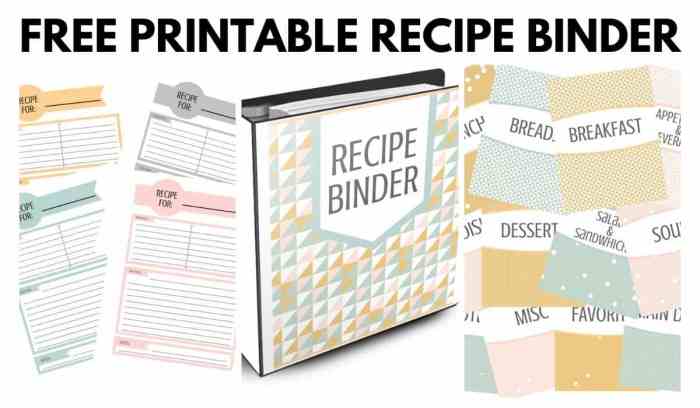
A recipe binder can be more than just a collection of recipes; it can be a reflection of your personality, culinary interests, and creativity. There are endless possibilities for making your recipe binder unique and inspiring.
Creative and Unique Recipe Binders
Here are some examples of creative and unique recipe binders:
- A recipe binder designed to look like a vintage cookbook, with a worn leather cover and handwritten recipes.
- A recipe binder with a personalized cover featuring a favorite food illustration or photograph.
- A recipe binder organized by cuisine or meal type, with dividers and tabs for easy navigation.
- A recipe binder with a built-in recipe index, making it easy to find specific recipes.
Recipe Binder Themes and Styles
There are many themes and styles that can be incorporated into a recipe binder, such as:
- Seasonal themes:A recipe binder could be themed around a specific season, such as spring, summer, fall, or winter, with recipes that are appropriate for that time of year.
- Culinary traditions:A recipe binder could be themed around a specific culinary tradition, such as Italian, Mexican, or French cuisine, with recipes that are representative of that tradition.
- Dietary restrictions:A recipe binder could be themed around specific dietary restrictions, such as gluten-free, vegan, or vegetarian, with recipes that meet those requirements.
- Cooking techniques:A recipe binder could be themed around specific cooking techniques, such as baking, grilling, or slow cooking, with recipes that showcase those techniques.
Decorating and Personalizing a Recipe Binder
There are many ways to decorate and personalize a recipe binder to make it truly your own. Some ideas include:
- Using fabric or wallpaper:Cover the binder with a fabric or wallpaper that reflects your personal style or the theme of the binder.
- Adding embellishments:Decorate the binder with embellishments such as ribbons, buttons, or charms.
- Creating a custom cover:Design a custom cover for the binder using a photo editing program or by hiring a graphic designer.
- Hand-lettering or calligraphy:Hand-letter or calligraph the title of the binder or add decorative flourishes to the cover.
Incorporating Technology into a Recipe Binder
Technology can be used to enhance and modernize a recipe binder. Some ideas include:
- Using a digital recipe app:Store recipes digitally in a recipe app that allows for easy searching, organizing, and sharing.
- Adding QR codes:Include QR codes on recipe pages that link to online videos or tutorials.
- Creating a digital index:Create a digital index for the binder that can be accessed on a computer or mobile device.
Outcome Summary
As you embark on your recipe binder journey, remember that it’s a personal reflection of your culinary passions. Embrace the process, explore different organizational methods, and most importantly, have fun! Your recipe binder is a dynamic tool that evolves alongside your culinary skills and tastes, ensuring that you always have a reliable source of inspiration and guidance in the kitchen.
